Hybrid work has undeniably become the norm for most companies, with the flexibility it offers set to remain a defining aspect of the workplace for the foreseeable future. In the wake of the evolving return to work movement, companies are actively encouraging employees to re-join the workforce at their physical offices. The adoption of this return to work strategy varies, influenced by factors such as industry, age group, city commute times, and job profiles.
While the situation remains dynamic, many organizations are beginning to find a balance, settling into a workweek structure that typically involves a few days in the office and the remaining days working remotely, especially in hybrid setups. If your organization is considering the shift to a hybrid model, the transition guide would prove to be a valuable resource.
Employer-Employee Ongoing Tug of War on ‘Return to Work’
Employers firmly believe that in-office collaboration and cross-functional discussions, are critical for innovation and business growth. It also serves as a conduit for employees to embrace organizational values and strengthen their sense of belonging.
Yet, it’s important to acknowledge that not all employees are equally enthusiastic about returning to the office. Their reasons are as diverse as their profiles and circumstances, including concerns about the cost and time associated with commuting, the comforts of working from home, the appeal of remote locations, and, for some, a natural resistance to change. In one striking example, a Silicon Valley-based semiconductor company reported that a substantial 72% of its employees, including new recruits, had not set foot in the office since the onset of the pandemic.
The ‘Return to Work’ Strategies
What can organizations do to attract employees back to the office and ‘earn the commute’? Here are a few workplace strategies we feel will help organizations attract employees return to work.
1. Optimise Collaboration
People come to the office for People, not Place. Collaboration is a key driver for employees to come to the office. As per Microsoft Work Trend Index Research 2022, 84% of employees would be motivated to go into the office if they could socialize with co-workers. There is also an issue of loneliness that some remote workers face. In a 2022 global survey, 72% of workers reported experiencing loneliness on a monthly basis.
Organisations need to play a proactive role in enabling collaboration. When employees plan their office visits, allowing them to nudge their colleagues, announcing their schedule with their collaboration circles upfront or sharing each other’s schedules can encourage employees to plan office visits in groups. Creating opportunities for social interactions among employees, such as team-building activities, trainings, lunch & learns and company-wide cross-functional events to brainstorm business-relevant ideas can also promote collaboration. Triggering collaboration amongst employees is a win-win scenario: employees are motivated to return to work, and employers successfully attain the organisational culture they desire.
2. Flexible Scheduling
Across various organizations, there is a widespread acknowledgment that employers are either enforcing formal mandates or making informal requests for employees to return to the office. While most companies are adopting a more flexible approach others are urging employees to return every day of the week. We firmly believe that imposing rigid mandates, unless dictated by the nature of the job, could be counterproductive and might prompt top talent to explore alternative options. A more thoughtful alternative is for organizations to establish guidelines, suggesting, for instance, that employees be present in the office for a specified number of days per week or month, aligned with their job profile. Explore various hybrid models and choose the one that suits you the most.
A progressive step in this direction involves transitioning to flexible scheduling arrangements, empowering employees to tailor their office hours, choose their workspace, and decide the days they prefer to work in the office. This approach recognizes the diverse preferences and workstyles of individuals; some may prefer an early arrival and departure, while others may favour a late day productivity. By clearly defining Key Performance Indicators (KPIs) and timelines, organizations can seamlessly integrate cross-functional teams within a flexible environment, allowing them to plan collaborative days for brainstorming and effective outcomes.
Ultimately, if organizations embrace flexibility and cultivate an enhanced office experience, employees are more likely to be content, engaged, and productive, leading to a higher frequency of them returning to work.
3. Foster a Positive Environment
In the current hybrid work landscape, employees no longer visit the office solely for routine desk jobs; their presence is driven by specific purposes, whether it’s collaboration or focused work. Recognizing this shift, many companies are revamping their office spaces to align with the actual needs of employees in a hybrid setup. This strategic approach involves reconfiguring existing office layouts and furniture to create versatile and collaborative workspaces that prioritize employee well-being. Elements include open-plan designs, flexible seating arrangements, and dedicated areas for different work styles, including quiet zones and collaborative spaces.
We advocate for companies to streamline the workplace experience, ensuring it is as frictionless as possible to boost employee productivity during office visits. The goal is for employees to perceive greater efficiency when working in the office compared to remote settings, encouraging regular visits.
Enhancing the workplace experience involves active engagement with employees while they are on-site. Implementing gentle nudges for breaks and mealtimes, suggesting optimal travel times based on traffic conditions, ability to provide instant feedback, and encouraging participation in surveys contribute to fostering employee engagement and well-being. Additionally, providing features like SOS alerts enhances the sense of safety among employees. Environmental considerations, such as comfortable ergonomic seating, ample natural light, and good indoor air quality, also play an important role in elevating the overall employee experience.
4. Improve Office Amenities
Office amenities made available to employees foster physical, emotional and community well-being. The absence of relevant amenities can significantly impact the overall employee experience, potentially deterring them from returning to the workplace.
Inclusive amenities such as ample parking space, secure locker facilities, meeting rooms with advanced audio/visual technology, private quiet pods, an on-site gym with shower facilities, and dedicated wellness rooms are among the most sought-after amenities that employees prioritize when planning their office visits.
An increasingly popular amenity provided by employers involves offering snacks, meals, and beverages to employees while they are in the office. Remarkably, there are instances where a surge in office attendance on specific days can be directly attributed to the menu choices available on those particular days.
In the current landscape of sporadic demand for office space, effective planning of amenities by the facilities team is important. Displaying the availability of amenities and offering a streamlined booking option allows employees to efficiently plan their office visits. This not only makes their experience better but also fits well with the changing nature of hybrid work, where flexibility and convenience are crucial in planning the return to work.
5. Choose Right Technology
In the wake of the pandemic, technology played a crucial role in facilitating a smooth transition to remote work, ensuring productivity and connectivity for employees. As we navigate the hybrid work landscape, technology continues to play an important role in orchestrating the return to work seamlessly.
According to the 2023 Gartner Workplace Experience (WEX) Market guide, a staggering 67% of corporate real estate leaders think that improving the employee workplace experience is the No. 1 priority and are increasingly working with the digital workplace team to optimize the hybrid experience. In this context, focusing on the availability and usage of technology emerges as a key area when planning the return to work.
Empowering employees with autonomy in shaping their work schedules, whether from the office or a remote location, stands out as a fundamental aspect. This can be achieved through user-friendly applications such as DB Spazio that allow employees to reserve workspaces and amenities based on their preferences for location, time, and date. Additionally, utilizing technology to facilitate schedule coordination with colleagues, enabling seat selection next to desired collaborators, and assisting in locating co-workers within the office space are all illustrative examples of leveraging the right technology for a seamless and productive in-office experience. Facilities and CRE teams can use the same technology to track space utilisation metrics to optimise their real estate needs.
Monitoring Indoor Air Quality (IAQ) levels and ensuring restroom hygiene through technology not only contribute to a healthier environment but also reassure employees of their well-being during their time in the office.
As organizations plan their return to work initiative, placing a significant focus on technology becomes crucial for enhancing the overall employee experience and fostering a successful transition to the hybrid work model. For a systematic approach, consider using our Return to Work Checklist to plan this effectively.

Conclusion – Ensuring a Successful Return to Work
In summary, a successful return to work hinges on a holistic approach encapsulated by the OFFIC model illustrated above. By Optimizing collaboration, Offering scheduling Flexibility, Fostering a positive environment, Improving office amenities, and Choosing the right technology, organizations pave the way for a seamless transition to the hybrid work era. These interconnected strategies not only entice employees back to the workplace but also guarantee their contentment and efficacy. As we navigate this dynamic shift, the OFFIC model emerges as a compass, guiding organizations towards creating an adaptive and thriving work environment for the future.




